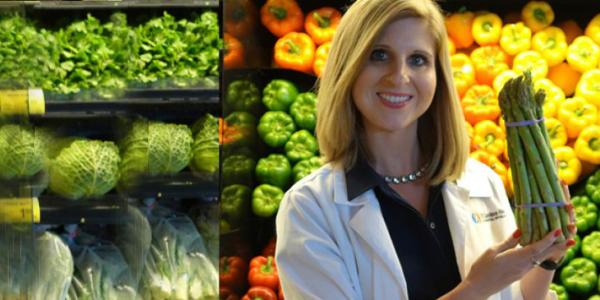
We all know that going to the grocery store on an empty stomach can be dangerous.
Your cart not only fills up faster but you might also be tempted to purchase foods that will satisfy your immediate hunger and are not particularly healthy choices. Many grab-and-go items, snack options and quick, heat-and-go meals are highly processed, high in salt and added sugar which over time can lead to health issues such as hypertension, diabetes and an increased risk for cancer.
The grocery store can be filled with products that call out for your attention, making it a challenge to get through. But here are easy tips to help you make better choices and eat healthier:
- Head straight for the produce department, spend most of your time in this area of the store and look for color. All those brightly colored fruits and vegetables reflect the vitamins, minerals and nutrients inside them. In general, the more colorful the produce item, the better it is for you! Think of all the beta carotene found in sweet potatoes versus a white potato or the nutrients in spinach compared to iceberg lettuce. Go for color!
- When it comes to breads, cereals and pasta, look for items made from whole grains and products with three grams or more of fiber per serving. When checking the ingredients, the less sugar, the better. Choose whole-grain bread and pasta, brown rice instead of white and try adding alternative grains such as quinoa, barley or bulgur to your recipes.
- Dairy products are a great source of calcium and vitamin D, so look for low-fat or nonfat options as well as single serving cheese and yogurts to help keep your portion sizes small and calories lower.
- When it comes to meat, fish and poultry, buy lean cuts of meat, opt for skinless poultry or remove the skin before eating, and try to incorporate fish into your meals at least twice a week.
- When shopping for canned foods, choose low salt options or vegetables canned without salt, and look for fruit that is packed in its own juice. Tuna packed in water and low fat soup are good options, as well as nut butters like all natural almond butter or peanut butter. Canned beans are also an easy and effective way to add protein and fiber into your soups, salads, pastas and rice dishes. Just be sure to rinse canned beans with water to effectively reduce the sodium intake.
- Olive, canola, avocado, walnut, sesame, sunflower, safflower, and grape seed oils along with assorted vinegars should also be part of your healthy pantry. Combine extra virgin olive oil and red wine or balsamic vinegar for a tasty, sodium free, and naturally low sugar salad dressing.
- Don’t be afraid of the frozen food aisle. The fresh produce you need or want may not be available because it isn’t in season. In these situations, frozen fruits and vegetables are perfectly acceptable alternatives.
- Stock up on raw nuts and seeds, which are easy to add to meals for a protein boost and make great snack mixes. Be sure to check the nutrition label on pre-packaged fruit and nut bars because certain items that advertise themselves as healthy may be packed with added sugars and preservatives.
- In general, when checking labels, look for foods with little or no sugar, salt or additives. Juices made from 100% fruit juice or 100% whole grain items with little or no processing will always be healthier options.
- Another rule of thumb is to look for foods that contain five or fewer ingredients and to watch out for ingredients that you can’t pronounce or are unfamiliar to you.
By following just a few of these simple tips, you can make healthier food choices and navigate your grocery store with confidence!

